The valve for the radiator. the principle of operation of
By types, the adjusting valve for radiators can be classified into two types - this is a mechanism with adjustable intensity of the coolant flow and discrete, which can be either open or closed.
If everything is clear with the first unit, the second, thermostatic, is divided into electronic with different types of logic and mechanical, with different fillers, on which the quality of operation depends. Therefore, we will focus more on thermostatic devices and their device, as well as watch the video in this article.
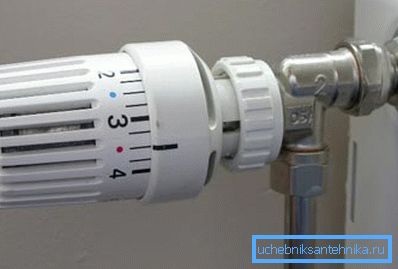
Climate control
The principle of operation of the thermostat
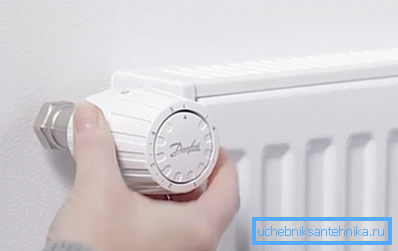
- The heat carrier that circulates in the heating system has a certain temperature, which is transmitted to the radiator, the heating air in the room, and the ordinary valve regulates the flow rate, making the battery cooler or hotter. In the case of thermostat, the temperature in the radiator is also regulated, but this is done automatically, depending on the air temperature in the room.
- The thermostatic control valve on the radiator has a filler (solid, liquid or gas) that reacts to the air temperature, that is, when heated, it expands and pushes the rod, blocking the passage of the coolant, and when cooled - narrows and the rod moves back, freeing the passage hot water circulating in the radiator. The electronic thermostatic controller works in a similar way, but it is much more accurate.
- For example, you set the tuning knob to 3 - it usually corresponds to 20? C, and the circulation of coolant will continue until the air temperature in the room rises to 21? C and when this happens, the filler will expand, the bellows will press on the rod and the passage will be blocked. When the air temperature in the room drops to 19? C, the filler will decrease in size and the water will push the stem back, opening a passage for itself to circulate in the radiator.
Mechanical thermostats
Note. All thermostatic regulators of mechanical type are divided into three groups according to filling the bellows with different fillers. So, it can be solids like paraffin, stearin or ozokerite, liquid, like alcohol or oil, or it can be a liquefied gas.
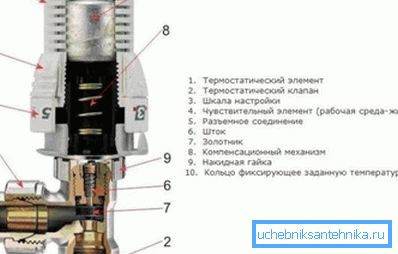
In cases where the bellows is filled with paraffin, stearin or ozokerite, the reaction process is rather inhibited - the filler reaches the required state only 40 minutes after the desired temperature has been established in the room.
And since the reaction of the device is programmed to one degree, it simply does not have time to work at the right temperature and the error, as a rule, already reaches 1.5 ?. That is, if you set 20 ?, then it will not work at 19-21? C, but at 17.5-22.5? C, respectively.
Another negative of such a device is the influence of extraneous factors, for example, paraffin wax can be heated from the back wall of a refrigerator, located nearby or cooled from drafts. However, mechanical devices with solid filler are considered the most reliable among their counterparts (liquid and gas), besides the price for them is somewhat lower.
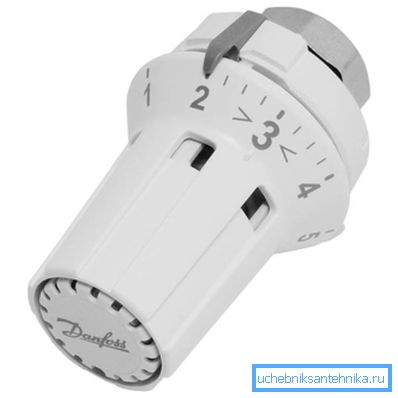
In cases where the regulator is filled with alcohol or oil, the bellows reacts much faster — this happens after 25 minutes — almost twice as fast as with a solid filler. In appearance, these taps are more compact, since the bellows here are smaller, therefore, the head with the adjustment knob is compressed in size.
Such a device can function correctly at a coolant temperature of 50-80? C, but the error is possible here and it, depending on the manufacturer, will be 0.9-1.5? C.
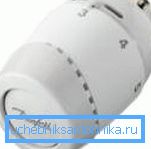
Among the mechanics, the most perfect is the thermostat with a gas bellows - its delay in reacting to an increase or decrease in temperature compared with solids and liquids is minimal.
It takes him only 8 minutes to react to a change in the air temperature in the room - compared to 25 and 40 minutes, this is very little! The reason here is quite simple - the bellows is as remote as possible from the walls of the regulator, which increases its sensitivity, since extraneous factors here can have only a minimal effect.
Note. Temperature controllers of any type, direct and angular, the instruction does not recommend to install near heating devices, in drafts and behind curtains. These factors contribute to the failure of the mechanism.
| Marking | Short description | Cost in € |
| RTD Inova 013L3132 | Gas. Remote sensor 6-26 | 22.92 |
| RTD 3640 013L3640 | Gas. Built-in sensor 6-26C | 14.84 |
| RTD 3120 013L3120 | Gas. Built-in sensor 6-26C | 22.35 |
| RTS 3620 013L3620 | Liquid. Built-in sensor 6-26C | 14.07 |
| RTS-K 3630 013L3630 | Liquid. Built-in sensor 6-26C | 14.07 |
| RTS Everis 013L4230 | Liquid. Built-in 8-28C sensor | 14.84 |
| RTD 3642 013L3642 | Gas. Remote sensor 6-26C | 20.31 |
| RTD-R 3110 013L3110 | Gas. Built-in sensor for RA valve | 14.84 |
| RTD Inova 013L3130 | Gas. Built-in sensor 6-26C | 16,13 |
| RTD 3562 013L3562 | Gas. Remote sensor 6-28C | 47.07 |
DANFOSS Thermostatic Controls Table
Electronic thermostats
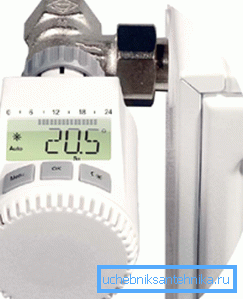
An electronic thermo-vent for a heating radiator can be of two types - with open and closed logic, that is, the first option is subject to programming, and the second is not.
They differ in application, so devices with closed logic are installed directly on radiators, and programmable regulators are installed in independent heating as a controller. It collects information about the temperature in each room using a remote sensor and thus has the ability to regulate the overall temperature.
A significant disadvantage of electronic thermostatic valves is their high cost and dependence on the power source. If the battery is dead or the battery is exhausted, the device stops functioning.
Note. When mounted on radiators, thermostats of any type, they (batteries) should always be provided with stop valves. This can be either a conventional ball valve or a cone valve.
Additional controls
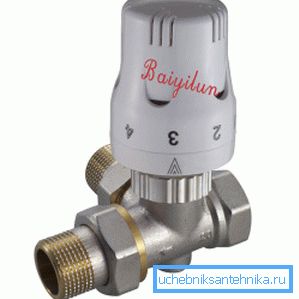
If you have a separate circuit installed on heating, that is, in addition to radiators, a floor heating system is also involved, then you will definitely have to install a balancing radiator valve, as the batteries and the floor need different temperatures. Depending on the design of the circuit (its branching), you can use a three-way or four-way thermostatic valve that redistributes the coolant over the desired (specified) temperature.
The principle of operation here is quite simple - from the boiler the coolant enters a three-way (four-way) valve with the same temperature that is needed to heat the radiators, but too high for a heated floor.
Therefore, the valve blocks the direction to the floor and discharges water into the return pipe — when the pipe on the floor cools down — the valve opens and circulation resumes to a certain temperature point.
Conclusion
In conclusion, I would like to mention the settings of thermostats, which must necessarily be made after their installation with their own hands - without them you will not be able to adjust the indoor climate. To do this, you need to close all windows and doors, turn the knob all the way to the left and wait until the temperature in the room rises above the required 5-6? C.
After that, turn the knob all the way to the right and wait until the temperature drops to the desired one, and slowly begin to open the regulator until you hear the sound of water - leave it in this position.